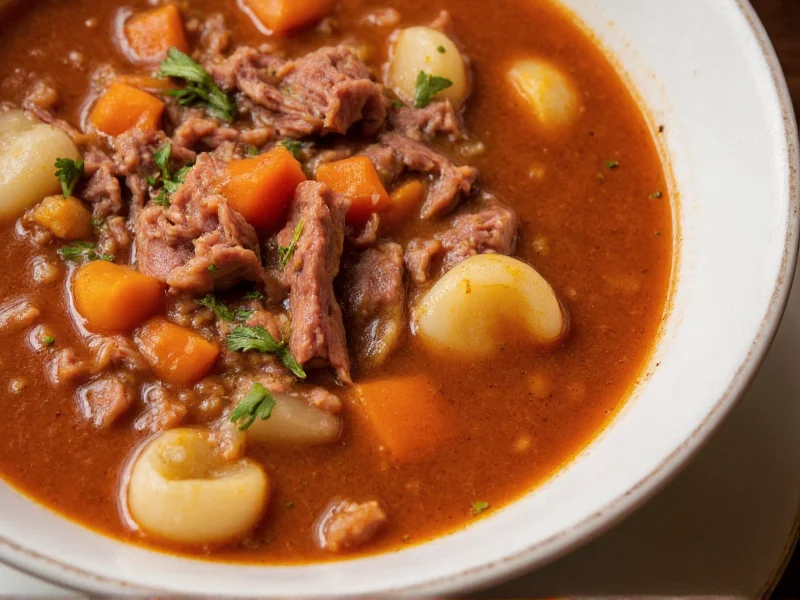The Rich History of Corned Beef Soup
Corned beef soup traces its origins to Irish and Jewish culinary traditions, though its modern form evolved through cultural adaptation. While corned beef itself has roots in腌制 techniques used by Irish farmers, the soup version became popular among Irish immigrants in America who combined their traditional corned beef with available vegetables. The "corn" in corned beef refers to the large "kernels" or grains of salt used in the curing process, not maize.
Essential Ingredients for Authentic Flavor
Creating the best traditional corned beef soup requires attention to ingredient quality. Start with a well-marbled corned beef brisket, preferably with the spice packet included. The classic vegetable trio includes cabbage, carrots, and potatoes, though regional variations might add parsnips or turnips. Don't skip the aromatics—onions, garlic, and fresh herbs like thyme and parsley elevate the broth significantly.
| Core Ingredients | Preparation Tips | Quantity for 6 Servings |
|---|---|---|
| Corned beef brisket | Rinse thoroughly to reduce saltiness | 3-4 lbs |
| Green cabbage | Cut into 1-inch wedges | 1/2 head |
| Carrots | Peel and cut into 1-inch pieces | 4 medium |
| Potatoes | Yukon Gold preferred, cut into chunks | 3 medium |
| Onion | Yellow, quartered | 1 large |
Step-by-Step Preparation Guide
For the most flavorful traditional corned beef soup recipe, begin by placing the corned beef in a large pot and covering with cold water. Bring to a gentle boil, then reduce to a simmer and cook for 2.5-3 hours until the meat is fork-tender. Skim foam regularly during the initial cooking phase. Add vegetables during the last 45-60 minutes of cooking to prevent overcooking. The cabbage should go in last, about 15 minutes before serving.
Pro Tips for Perfect Results Every Time
Avoid common mistakes that ruin homemade corned beef soup. Never boil the meat vigorously—maintain a gentle simmer throughout cooking. If using store-bought corned beef, rinse it thoroughly to remove excess salt. For deeper flavor, brown the meat briefly before simmering. Save some cooking liquid before adding vegetables to create a clearer broth if desired. The fat layer that forms on top can be skimmed off for a leaner soup or left for richer flavor.
Modern Cooking Methods
For those seeking how to make corned beef soup from scratch with less hands-on time, slow cooker and pressure cooker methods work exceptionally well. In a slow cooker, combine all ingredients and cook on low for 8-10 hours. With an Instant Pot, use the pressure cook function for 60 minutes followed by natural release. These methods produce equally tender results with minimal supervision, making them ideal for busy cooks.
Serving Suggestions and Pairings
Serve corned beef soup hot with crusty bread or Irish soda bread for dipping. Traditional Irish pairings include a slice of sharp cheddar cheese and a glass of dry stout. For a complete meal, add a simple green salad with vinaigrette dressing. Leftover corned beef soup with cabbage makes excellent next-day lunches as flavors continue to develop.
Popular Variations to Try
While the classic recipe remains beloved, creative corned beef soup variations abound. Add diced tomatoes for a slightly acidic note, include barley for heartier texture, or stir in a tablespoon of horseradish for extra kick. Some regional versions incorporate turnips or parsnips for earthier flavor profiles. For a lighter option, substitute some broth with vegetable stock and increase the vegetable quantity.
Storage and Reheating Guidelines
Proper corned beef soup storage tips ensure maximum freshness and safety. Cool the soup completely before transferring to airtight containers. Refrigerate for up to 4 days or freeze for 3 months. When reheating, bring to a gentle simmer rather than boiling to preserve texture. The vegetables may soften further upon reheating, so consider adding fresh vegetables to leftovers for better texture.
Nutritional Profile
A standard serving (1.5 cups) of traditional corned beef soup contains approximately 320 calories, 18g protein, 25g carbohydrates, and 15g fat. It provides significant amounts of vitamin C from the vegetables and iron from the beef. For a lower-sodium version, rinse the corned beef thoroughly and use low-sodium broth. Adding extra vegetables increases fiber content while reducing the overall fat percentage.
Frequently Asked Questions
What's the difference between corned beef and regular beef brisket?
Corned beef starts as beef brisket but undergoes a curing process in a brine containing salt, sugar, and spices (typically including peppercorns and coriander) for 5-7 days. This curing gives corned beef its distinctive pink color, salty flavor, and more tender texture compared to uncured brisket.
Can I use leftover St. Patrick's Day corned beef for soup?
Yes, leftover cooked corned beef works well for soup. Simply dice the meat and add it during the last 15-20 minutes of cooking to heat through without overcooking. You'll need to adjust liquid quantities since pre-cooked meat has already released some of its broth.
Why does my corned beef soup taste too salty?
Excessive saltiness usually comes from insufficient rinsing of the corned beef before cooking. Always rinse the meat thoroughly under cold water before simmering. If your soup is already too salty, add peeled potatoes to absorb excess salt, or dilute with additional unsalted broth or water.
How can I make corned beef soup without cabbage?
For corned beef soup without cabbage, substitute with additional root vegetables like turnips, parsnips, or celery root. You can also create a Manhattan-style version with tomatoes and green beans. The cooking method remains the same—simmer the corned beef first, then add your chosen vegetables during the final 45 minutes.
What are the best leftovers corned beef soup ideas?
Transform leftover corned beef soup into corned beef hash by sautéing the meat and vegetables with diced potatoes until crispy. You can also use the components separately—shred the beef for sandwiches, puree the vegetables for a new soup base, or dice everything for a hearty omelet filling.











 浙公网安备
33010002000092号
浙公网安备
33010002000092号 浙B2-20120091-4
浙B2-20120091-4